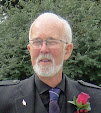Of
course the work didn't end there. The pile of peats had to be stacked.
This was an art in itself but art with a purpose. The peats on the
outside were placed in such a way that the rain was directed away from
the centre of the stack. These stacks are at the Arnol Blackhouse which
is looked after by Historic Scotland.
 |
| Peat stacks at the Arnol Blackhouse on Lewis |
Overall, working at the peats could be a wonderful or hellish experience depending on the day and the circumstances. I can recall being out on the moor on a perfect late spring or early summer midge-free evening listening to the merlin, curlews and other birds and the gentle wind with not another sound to be heard. I can remember picnics and comradeship and fun which lessened the hard work. On the other hand, in the days before midge nets, I remember bringing the peats home when every peat that was lifted brought with it a cloud of wretched little creatures which filled the ears, nose and eyes.
And then
there was the lost wellington boot. Some of 'the family of incomers'
were out cutting at Marcel's peat banks out on the Pentland Road (where
the Stornoway grazings were). Suddenly Marcel started to sink into the
peat. By the time the rest of us had stopped laughing Marcel was up to
his thighs in the muddy peat and we realised that this was a situation
that needed some attention and thought. Eventually an extremely annoyed
Marcel was extricated from the mire minus a wellington boot. That was
the end of the evening's work. I always imagine that at some time in the
distant future the single boot will be discovered amid bemused
speculation.
Today there are few banks being cut: few people have the time or the inclination and the ease and warmth of other forms of heating is very attractive. I notice that there are a few banks being cut but it seems to be on a very small scale and so far I've only see one or, at most two, people involved on any bank. Culturally I suppose it is a sadness as that part of society's life has gone. Environmentalists, though, will be happy: peat is hardly a green fuel environmentally.
The End.
Today there are few banks being cut: few people have the time or the inclination and the ease and warmth of other forms of heating is very attractive. I notice that there are a few banks being cut but it seems to be on a very small scale and so far I've only see one or, at most two, people involved on any bank. Culturally I suppose it is a sadness as that part of society's life has gone. Environmentalists, though, will be happy: peat is hardly a green fuel environmentally.
The End.








